Our hand-hewn dugout canoe bumped against a muddy bank that materialized out of the soft fog hanging over the Rapti River in Chitwan National Park. Regretting that we had to leave the ethereal, misty river so soon, I gingerly walked the length of the narrow wooden boat, trying not to upset its delicate balance and scrambled up the embankment for a pre-trek briefing. Earlier, our guide had warned us to be on the lookout for crocodiles and poisonous snakes, which occasionally jump into the boats. Even so, the canoe had felt relatively safe, but now we were standing in thigh-high jungle vegetation dotted by an occasional small tree.
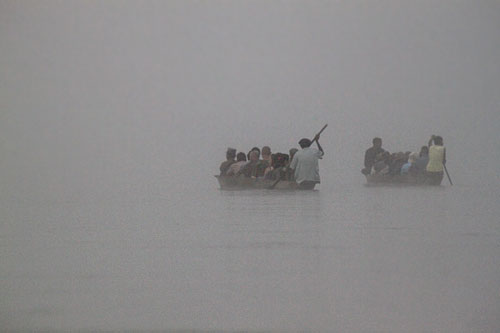
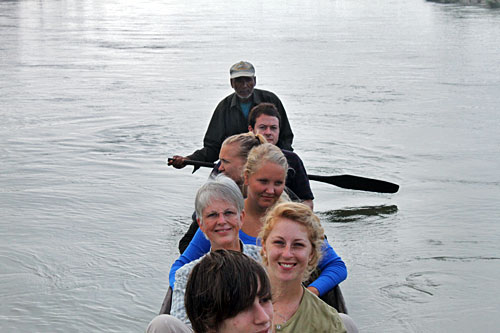
As a veteran of a nine-day safari through Tanzania’s National Parks and a day tour in Botswana’s Chobe National Park, I am no stranger to safaris. However in Africa we were not allowed out of the car, with one exception; in Arusha National Park I strolled through herds of warthogs, water buffalo and giraffe, accompanied by an automatic rifle-toting park ranger. Here, the only weapon allowed our guide was a long stick.
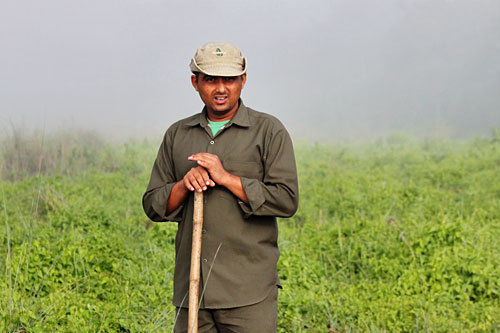
“Chitwan National Park is home to sloth bears, tigers, elephants, and the endangered one-horned rhinoceros, so we must be prepared before trekking,” he explained. “If we encounter a sloth bear, you must run and climb a tree; a small tree is OK. If we have problems with rhinos you must run as fast as you can and climb a larger tree. Do you know what to do if we come upon a tiger?”
“Run?” one of us suggested meekly.
“No. You must back up very slowly. Then you turn and run.”
“And what about an elephant?” one of us inquired.
“You cannot run from an elephant and climbing a tree will not help. If an elephant charges, you die.” And with this final comment he turned and headed off into the jungle.
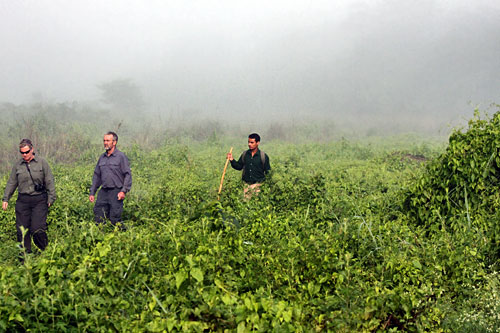
I had no illusions about encountering a tiger, as they are shy nocturnal animals that are rarely sighted. The closest we would get to a tiger was likely the enormous fresh paw print encased in the mud just feet from where our canoes had landed. It was the rhinos that I had come to see, since they were the only one of the “Big Five” animals that had eluded me during my African safaris. Thus despite our Nepali guide’s alarming instructions, I fell in right behind him on a narrow but well-worn footpath, reasoning that the relatively open landscape would allow us to spot any large animals in time enough to flee. A dozen steps later my theory was rendered useless when he suddenly turned off the path and headed into dense riverine forest where there was no hint of a trail.
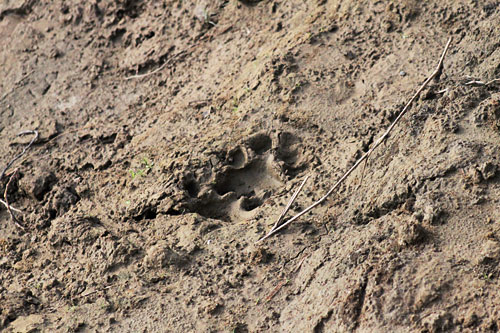
“Too many people in other groups on the paths – too noisy. We will never find rhinos if we follow them,” he whispered.
Carefully, I matched his footsteps as we ducked under tree branches and avoided dry twigs that cracked and echoed like sonic booms when stepped upon. I was so focused on the ground that I nearly ran into him when he stopped abruptly and crouched down.
“Deer, antelope,” he said, pointing to a distant thicket.
When my eyes finally adjusted to the dim light, a herd of deer emerged from the mottled brown and green palette. We continued deeper into the forest, where supple vines snatched and curled around my ankles, tripping up any foot not carefully planted. Through a gully and over an embankment, we checked a wallow hole our guide knew to be a favorite of the rhinos but it was empty. Gradually the landscape changed from high canopy hardwood to marshland with small bushes and trees, none of which where tall enough to provide protection from a rhino. And of course, that is where we found them, lying in a muddy pond too far away for decent photos.
Our guide put a finger to his lips, signaling us to follow quietly. He threaded expertly through soggy bottomland and circled around to a small opening that looked directly into the water hole. One-by-one, he motioned us forward for photos.
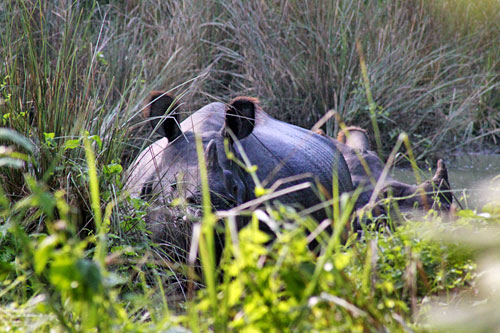
“Quickly,” he hissed in my ear as I stepped up. I’d hardly had time to snap two shots when the first rhino stood up, looked directly at us, flapped its ears, and took a threatening step in our direction.
“Run!” he insisted, shoving me back into the obscuring vegetation.
He didn’t have to tell me twice. Fortunately, the rhinos chose not to pursue us, for if they had, our willy-nilly headlong crash through the jungle would have easily led them to us. Finally, our guide judged us to be a safe distance from the rhinos and hollered for us to stop. We regrouped and were headed for the elephant breeding camp when the guide tugged me backwards and pointed to something moving stealthily through a dark thicket about 20 feet away.
“Monkey,” he said excitedly. I saw movement but couldn’t make out any details; hoping for the best I raised my telephoto lens and shot in the direction of his finger. Later, I looked at the result. The photo certainly shows an animal of some kind, although the fuzzy image is more reminiscent of Sasquatch than a monkey.
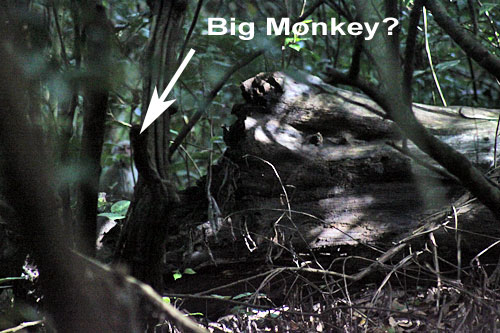
A few minutes later we emerged into open plain and stopped for a leech check. Despite long socks, boots, long pants, and long-sleeved shirts buttoned at throat and wrists, one woman found a leach feasting on her groin and several others picked them off their backs. My friend Sherry Ott, who writes about worldwide travel at Ottsworld.com and spent a month volunteering in Nepal, had forewarned me about leeches so I’d been on the lookout and had picked one off my trousers and another off my arm before they could sink their blood-sucking mouths into my soft flesh.
Even with the mud, dripping perspiration, slimy leeches and threat of poisonous snakes, I’d do it again in a heartbeat, just for the thrill of standing a couple hundred feet from one of the world’s most dangerous wild animals, protected only by a stranger armed with a stick.
Giri Gurung, managing director of Nepal Tourism Travels & Adventures, organized a portion of my travels in and around Nepal, including my trips to Nagarkot, Changu Narayan, Chitwan National Park, and an amazing four-day homestay with his family, high up in the mountains above Besishahar, in the tiny village of Puma. Nepal Tourism Travels & Adventures office is in Kathmandu, conveniently located in the Thamel backpacker district. Their website is www.nepaltourismtravels.com.np, and Giri’s email is [email protected] or [email protected].

Animals are the biggest draw towards Chitwan National Park Nepal. There are some amazing species of animals to be found here. There are about 40 types of mammals living in this park, with another 45 species of reptiles and amphibians, and more than 450 types of birds. Elephants, Indian rhinos, and sloth bears are amongst the favorites amongst the visitors, while predators such as tigers, leopards, and march crocs wander the jungle.
Wow! I can’t imagine being face to face with the Rhino. Reading your post makes me wish we went to Chitwan. Everyone told us a Rhino Sighting was guaranteed, but we were just too lazy at the time. Oh well, it gives us an excuse to go back to Nepal!
Hi DavenDeb: Nepal has declared 2011 as Nepal Tourism year, so they are
pulling out all the stops. Just met with a rep of the Tourism Board in
Pokhara yesterday and there will be no better time to come!
Very cool that you were able to spot a rhino! Not everyone that visits gets that kind of luck. We chased one on the back of an elephant… sketchy to say the least! We’ve enjoyed reading your Nepal posts. We really loved our time there. Cheers! 😉
Hi Traveling Canucks: I had an opportunity to do the elephant safari one
afternoon but declined. I had previous ridden an elephant in Cambodia and
was appalled by the way the mahouts stuck a pointed stick into the
elephant’s forehead to get it to do what they wanted – and it was no gentle
poke, either. So, I committed to never again ride an elephant. Of course,
that is a personal decision; I don’t make judgments about others who do ride
elephants, and having had an up-close encounter with a rhino on foot, I can
definitely see how the elephant option would be much safer! And it does seem
that the elephants in Nepal are treated much better than those at Angor Wat.
Those in the breeding facility at Chitwan are released to roam free in the
jungle much of each day and enticed back each evening with a big ball of
molasses-infused straw. So glad you loved Nepal as much as I do and that
you’re enjoying my posts.
I’ve been on safaris in Kenya and Sri Lanka, but only walked very briefly — and never had to run! I had never thought of Nepal as a wildlife destination, but this sounds like yet another phenomenal experience, the type of thing we travel for… Thanks for sharing.
Hi Theodora: I was also surprised that Nepal was a safari destination, but
pleasantly so. It was definitely a unique experience!
Your guide certainly didn’t sugarcoat the elephants!
Hi Anil: No kidding. I initially thought it was all part of some elaborate
drama that they set up with eveery group, but when we came face to face with
the rhinos on foot and they stood up as if to charge, and he said
run….well, I decided it was a lot more real than that!
Wow! You had an amazing time! We were in chitwan only a week ago and had no such luck at spotting rino’s! I’m gald you got to see them and some great photos too! I can live through your photos!
Hi Elise: I am so sorry you didn’t find the rhinos! They were an amazing,
thrill-inducing sight.
Wow, what an amazing journey Barbara. Makes me want to go to Nepal even more now. Of course your beautiful writing helps as well 🙂
Thank you, Todd. As always, you are too kind.
Hi Thomas: Thanks so much for your comment and glad I could bring back fond memories with my photos.
How cool – I’ve never actually been to Chitwan – but I love the idea of a hike through it. I thought you would have had to stay in cars or something. Love the photo of the Rhino!
Ahhh the lovely leeches…I don’t miss them. However I did get used to them! Glad you had such great sightings!
Hi ottsworld: I remember you saying that the word for leeches is the only Nepali word you remembered, and now I know why!
I am so happy that you completed your “Big Five”. The big monkey photo reminds me of how the news of sightings of Big Foot/Yetis/Abominable Snowmen are reported – thick forest, hazy photo of the animal, dingy lighting. Chitwan sounds a special place.
Hi Mark: Chitwan is a really interesting place – not at all what I expected for “jungle.” Strange how places that are described as jungle can be so very different.
I remember all this, as if I could forget! Great to see your photos and relive the experience a little.Feel free to drop me a line if you ever make it to England.
Dear Barb, the pictures you take are as beautiful as your writing !
Wow, what an insanely amazing experience!!! I bet you were on a high for the rest of the day after that?
Absolutely butterfly! Covered in mud, dripping sweat, and exhausted, but
full of adrenaline!
My god but you had me on the edge of my seat there -literally, I assure you! Marvellous adventure and great writing. Can’t wait for the next!!
WOW!!!!!
Barbara, you amaze me. I’ve been stuck with my nose in a manuscript since I met you and look at the places you’ve been. Another fascinating piece, my friend.
Hello my dear friend FICWRITER: Yes, I have been many places, but you will
soon have a book published and my dream of doing so is still not within
reach. It is I who envy YOU. Much love.